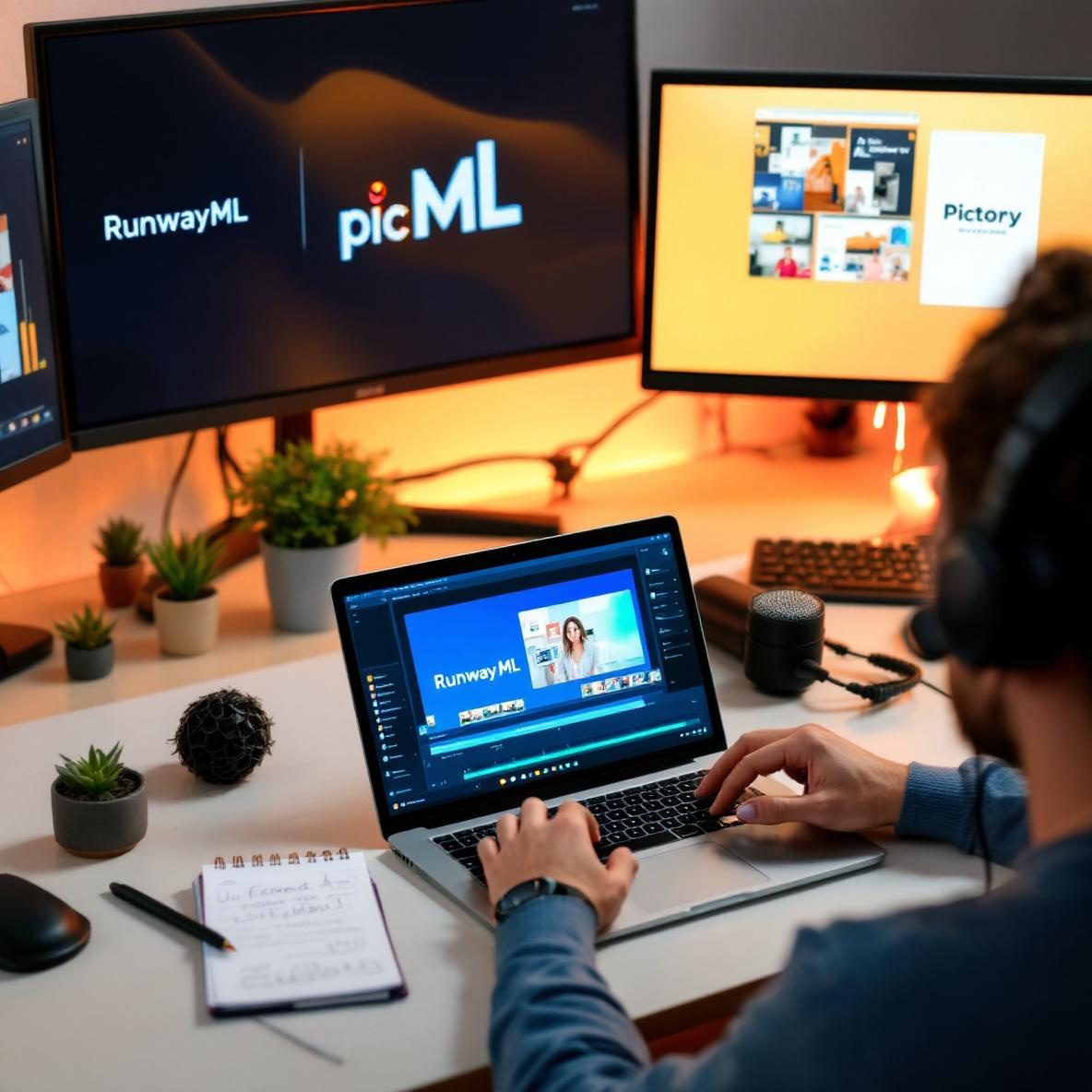What RunwayML and Pictory Actually Do
Both RunwayML and Pictory are AI-powered video content tools, but they feel wildly different when you get your hands on them. RunwayML acts more like a creative sandbox for editors, offering AI video editing, green screen effects (without the screen), and text-to-video generation that feels closest to something you’d find in a high-end editing suite. Pictory, on the other hand, is way more focused on automating video creation from text — think blog-to-video or transforming Zoom call transcriptions into LinkedIn snippets.
Thank you for reading this post, don't forget to subscribe!In my test run, I uploaded a talking head video into both tools — same raw file, similar duration (roughly five minutes), minimal background visuals. RunwayML’s environment felt closer to Final Cut or Premiere, with timelines, layers, and the option to crank the AI tools up or down. Pictory pulled the transcript immediately and split the video into bite-sized segments almost automatically, highlighting text it deemed quote-worthy.
The biggest difference right away: RunwayML invites you to stay and create. Pictory wants you to get in and out fast, batch-style, like you’re on deadline. They’re not trying to solve the same problem, but they cross over more than you’d think.
| Feature | RunwayML | Pictory |
|---|---|---|
| Interface Type | Creative editor panel | Text-based clip manager |
| Video Input | Any video or image prompt | Articles, Zoom calls, scripts |
| AI Focus | Text-to-video, frame interpolation | Text-to-summarized video |
| Ideal For | Creators, editors, indie projects | Marketers, agencies, coaches |
Overall, if you want to experiment and fine-tune what AI gives you, RunwayML has a deeper toolbox. Pictory’s more robotic in its delivery, but if all you need is snappy video content without touching a timeline, it nails that rhythm.
To wrap up, they share AI DNA but their personalities couldn’t be more different.
Testing the Video Editing Capabilities Side by Side
I wanted to compare how these two actually edit videos, so I picked a use-case most beginners would try first: turn a short script into a polished-looking clip. I used the same 3-line voiceover clip in both tools, aiming for a 30-second explainer-style output.
In RunwayML, I had to first type out a prompt like “cinematic city skyline at dusk — drone angle.” It generated a video backdrop in a couple minutes. Then I had to upload the voice track, add it to the timeline manually, and tweak the visual speed to match the voice pacing. There were no unexpected crashes, but some AI renderings were blurry or had random flickers in the clouds, which broke immersion. When I toggled the realism setting higher, the tool re-rendered with steadier frames but it was noticeably slower.
Pictory’s approach was rivetingly different. I pasted the exact script into the editor panel, and it auto-paired visual scenes from its stock library using keywords. It also generated subtitles on the fly — accurate within around 1-2 words. But here’s the catch: every scene is locked to roughly 3 seconds. You can’t stretch scenes unless you delete text or move segments. The voiceover synced automatically, but the monotone AI narrator wasn’t usable — I had to upload my own voice track for it to feel human.
Noteworthy bugs:
- RunwayML occasionally replaced a scene entirely when you changed a single word in a prompt — resetting styling without warning.
- Pictory forced auto-captioning even when I disabled subtitles, making me re-export three times before it finally complied.
Based on these real tests:
- RunwayML gives you control but makes you do more heavy lifting
- Pictory makes safe, structured edits — but you can’t push beyond its limits
Ultimately, creating something cinema-like is easier in RunwayML, but creating something ready to post in 10 minutes is what Pictory does best.
Speed and Workflow Differences in Actual Use
When I ran simultaneous projects on both tools with roughly five-minute video assets, the workflow bottlenecks became way more visible.
Timeline of work in RunwayML:
- Prompt-based video generation took about 4–6 minutes.
- Audio syncing was tricky — no markers, so I used manual waveform alignment.
- Export options required multiple codec choices (good if you know them, scary if you don’t).
Timeline of work in Pictory:
- Text input led to an instant storyboard; visuals slotted in under 60 seconds.
- You drag-n-drop voiceover, and everything else adjusts itself. Zero render delays up front.
- Export defaults to MP4, basic resolution presets. No real options, but no friction either.
What tripped me up in Pictory was the lack of an undo button. If you delete a scene, it’s gone — no Ctrl+Z. Meanwhile, RunwayML’s feisty “autonomy” sometimes makes tweaks look different every time you re-render a scene with the same prompt. It’s like it changes its mind every hour.
For solo creators, RunwayML might feel rewarding but slow. For a team publishing dozens of videos a week, Pictory saves hours even if some of the videos look templated.
To conclude, Pictory wins on throughput, but RunwayML lets you sculpt the thing from scratch like clay.
Use Cases Where Each Tool Excels
There’s not really a direct clash between the platforms if you know what you’re after. This became super clear when I gave both the same job — take a boring blog post and turn it into something shareable.
Pictory nailed it. From a plain Google Doc, I pasted a chunk of text and within minutes it delivered:
- A vertical video formatted for social
- Auto-subtitles that looked just like TikTok-style captions
- Transitions, music beds, and stock footage all layered in without any clicks
RunwayML was no help for this. There’s no text input-to-video function unless you go through the Gen-2 model prompts — and even then, the output was more abstract, like generative art based on a theme. Cool for trailers. Useless for content repurposing.
RunwayML, though, crushed it in creative briefs — like when I typed: “90s style MTV commercial, paint exploding, VHS grain.” It built a 12-second clip full of glitchy overlays and chromatic riffs that would’ve taken me half a day to mock up in Final Cut manually.
Each tool does one area extremely well — but only one.
In summary, Pictory is a repurposing engine, while RunwayML is an invention lab.
Limitations and Annoyances After Extended Use
After a week of heavy use, both had their fair share of frustrations. RunwayML’s biggest pain point became upload limits — especially when trying to layer background audio over more than two tracks. The interface sometimes refused to save timeline positions unless I clicked away and returned to the window.
Pictory’s issues were subtler but persistent. The auto-cut detection sometimes split sentences mid-phrase (“…without warning” would be placed awkwardly onto the next clip). There’s no way to group elements or move multiple scenes at once, which gets annoying when fine-tuning timing. Also, all their stock visuals have the same library “feel,” which gets noticeable fast if you’re making more than five videos per week.
One unexpected glitch: I tried syncing a music bed underneath a voice recording in Pictory, expecting volume ducking to kick in — but it didn’t. The music overpowered everything, and no setting fixed it. Workaround? I had to export both layers separately and remix them in Audacity. That defeats the “all-in-one platform” vibe a bit.
As a final point, both tools got tiring in different ways — one through overloaded knobs, the other through rigid rails.
Which One to Choose Depending on Your Workflow
If your workflow centers on speed, volume, and brand consistency, Pictory is the stronger contender. Its templated, no-fuss workflow is basically built for publishing calendars, social managers, and YouTube shorts. It’s your video content factory.
If your workflow is artist-driven, with custom visuals, transitions, or layered storytelling, RunwayML unleashes exactly that. You’re going to spend more time in it, maybe even curse it once or twice, but the outputs feel like you.
Potential workflow stacks:
- Pictory + Descript — For content batching from long-form sources
- RunwayML + Premiere — For layering expressive AI with traditional editing
- RunwayML + Figma — For styleboarding cinematic aesthetic tests
Overall, the question isn’t “Which is better?” but rather, “Where do you spend your creative energy?”






